Akt3 controls vascular endothelial growth factor secretion and angiogenesis in ovarian cancer cells
- PMID: 21351097
- PMCID: PMC3189303
- DOI: 10.1002/ijc.26010
Akt3 controls vascular endothelial growth factor secretion and angiogenesis in ovarian cancer cells
Abstract
The PI3 kinase/Akt pathway is commonly deregulated in human cancers, functioning in such processes as proliferation, glucose metabolism, survival and motility. We have previously described a novel function for one of the Akt isoforms (Akt3) in primary endothelial cells: the control of VEGF-induced mitochondrial biogenesis. We sought to determine if Akt3 played a similar role in carcinoma cells. Because the PI3 kinase/Akt pathway has been strongly implicated as a key regulator in ovarian carcinoma, we tested the role of Akt3 in this tumor type. Silencing of Akt3 by shRNA did not cause an overt reduction in mitochondrial gene expression in a series of PTEN positive ovarian cancer cells. Rather, we find that blockade of Akt3, results in smaller, less vascularized tumors in a xenograft mouse model that is correlated with a reduction in VEGF expression. We find that blockade of Akt3, but not Akt1, results in a reduction in VEGF secretion and retention of VEGF protein in the endoplasmic reticulum (ER). The reduction in secretion under conditions of Akt3 blockade is, at least in part, due to the down regulation of the resident golgi protein and reported tumor cell marker, RCAS1. Conversely, over-expression of Akt3 results in an increase in RCAS1 expression and in VEGF secretion. Silencing of RCAS1 using siRNA inhibits VEGF secretion. These findings suggest an important role for Akt3 in the regulation of RCAS1 and VEGF secretion in ovarian cancer cells.
Copyright © 2011 UICC.
Figures
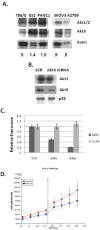
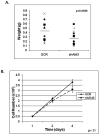


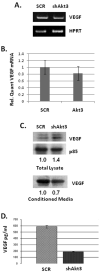

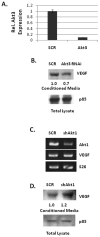
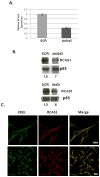

Similar articles
-
PTEN regulates angiogenesis through PI3K/Akt/VEGF signaling pathway in human pancreatic cancer cells.Mol Cell Biochem. 2009 Nov;331(1-2):161-71. doi: 10.1007/s11010-009-0154-x. Epub 2009 May 13. Mol Cell Biochem. 2009. PMID: 19437103
-
Loss of Mel-18 induces tumor angiogenesis through enhancing the activity and expression of HIF-1α mediated by the PTEN/PI3K/Akt pathway.Oncogene. 2011 Nov 10;30(45):4578-89. doi: 10.1038/onc.2011.174. Epub 2011 May 23. Oncogene. 2011. PMID: 21602890
-
VEGF stimulation of mitochondrial biogenesis: requirement of AKT3 kinase.FASEB J. 2008 Sep;22(9):3264-75. doi: 10.1096/fj.08-106468. Epub 2008 Jun 4. FASEB J. 2008. PMID: 18524868 Free PMC article.
-
Repression of microRNA-21 inhibits retinal vascular endothelial cell growth and angiogenesis via PTEN dependent-PI3K/Akt/VEGF signaling pathway in diabetic retinopathy.Exp Eye Res. 2020 Jan;190:107886. doi: 10.1016/j.exer.2019.107886. Epub 2019 Nov 21. Exp Eye Res. 2020. PMID: 31759996
-
Downregulation of AKT3 Increases Migration and Metastasis in Triple Negative Breast Cancer Cells by Upregulating S100A4.PLoS One. 2016 Jan 7;11(1):e0146370. doi: 10.1371/journal.pone.0146370. eCollection 2016. PLoS One. 2016. PMID: 26741489 Free PMC article.
Cited by
-
A novel tumor suppressor protein encoded by circular AKT3 RNA inhibits glioblastoma tumorigenicity by competing with active phosphoinositide-dependent Kinase-1.Mol Cancer. 2019 Aug 30;18(1):131. doi: 10.1186/s12943-019-1056-5. Mol Cancer. 2019. PMID: 31470874 Free PMC article.
-
Gynecologic Cancer, Cancer Stem Cells, and Possible Targeted Therapies.Front Pharmacol. 2022 Feb 16;13:823572. doi: 10.3389/fphar.2022.823572. eCollection 2022. Front Pharmacol. 2022. PMID: 35250573 Free PMC article. Review.
-
Dysregulation of AKT3 along with a small panel of mRNAs stratifies high-grade serous ovarian cancer from both normal epithelia and benign tumor tissues.Genes Cancer. 2017 Nov;8(11-12):784-798. doi: 10.18632/genesandcancer.164. Genes Cancer. 2017. PMID: 29321820 Free PMC article.
-
AKT Isoforms Interplay in High-Grade Serous Ovarian Cancer Prognosis and Characterization.Cancers (Basel). 2022 Jan 8;14(2):304. doi: 10.3390/cancers14020304. Cancers (Basel). 2022. PMID: 35053468 Free PMC article.
-
Cancer Markers Selection Using Network-Based Cox Regression: A Methodological and Computational Practice.Front Physiol. 2016 Jun 17;7:208. doi: 10.3389/fphys.2016.00208. eCollection 2016. Front Physiol. 2016. PMID: 27378931 Free PMC article.
References
-
- Berra E, Milanini J, Richard DE, Le Gall M, Vinals F, Gothie E, Roux D, Pages G, Pouyssegur J. Signaling angiogenesis via p42/p44 MAP kinase and hypoxia. Biochem Pharmacol. 2000;60:1171–8. - PubMed
-
- Pages G, Milanini J, Richard DE, Berra E, Gothie E, Vinals F, Pouyssegur J. Signaling angiogenesis via p42/p44 MAP kinase cascade. Ann N Y Acad Sci. 2000;902:187–200. - PubMed
-
- Semenza GL, Agani F, Feldser D, Iyer N, Kotch L, Laughner E, Yu A. Hypoxia, HIF-1, and the pathophysiology of common human diseases. Advances in experimental medicine and biology. 2000;475:123–30. - PubMed
Publication types
MeSH terms
Substances
Grants and funding
LinkOut - more resources
Full Text Sources
Medical
Research Materials
Miscellaneous

